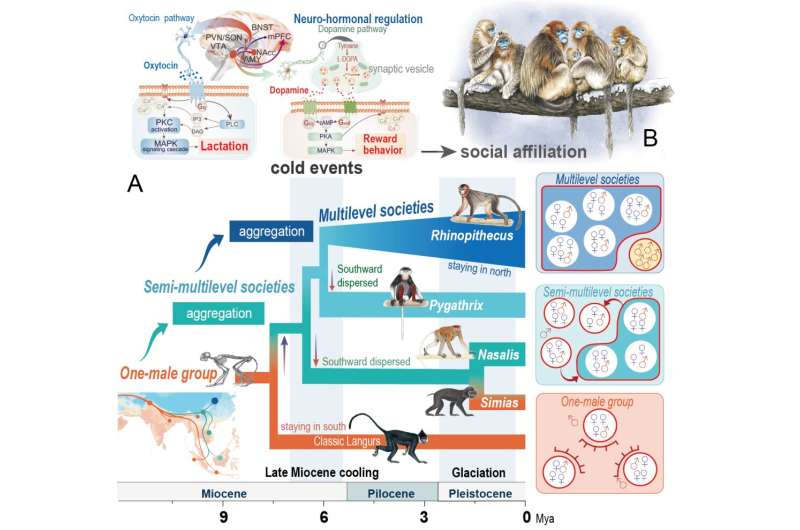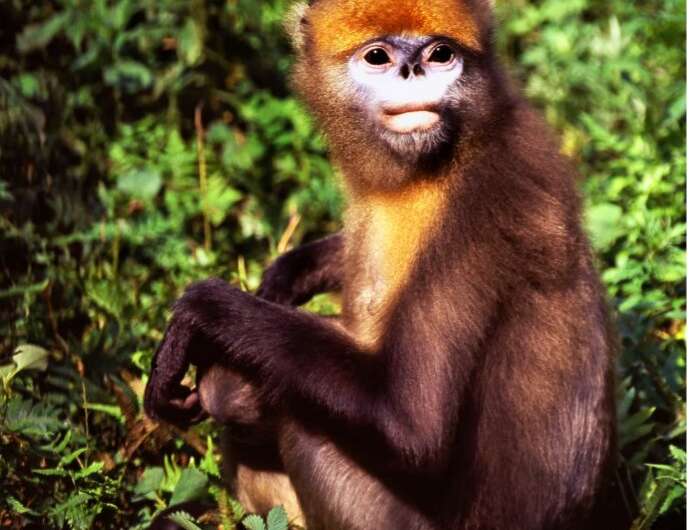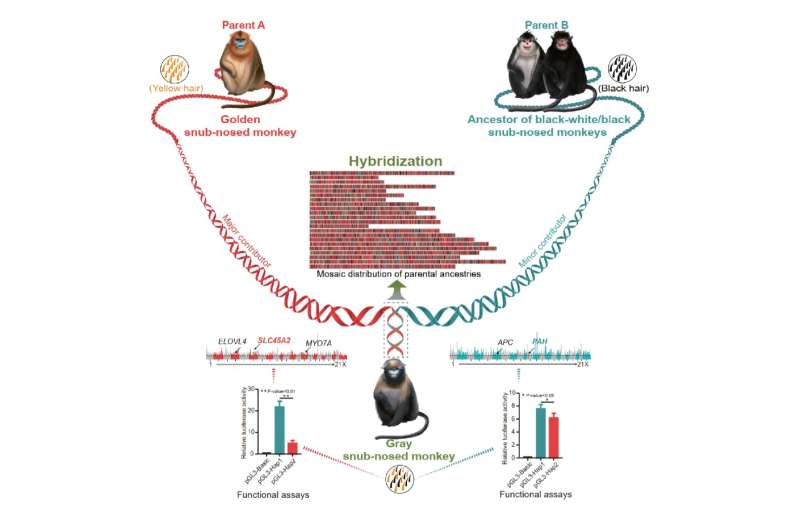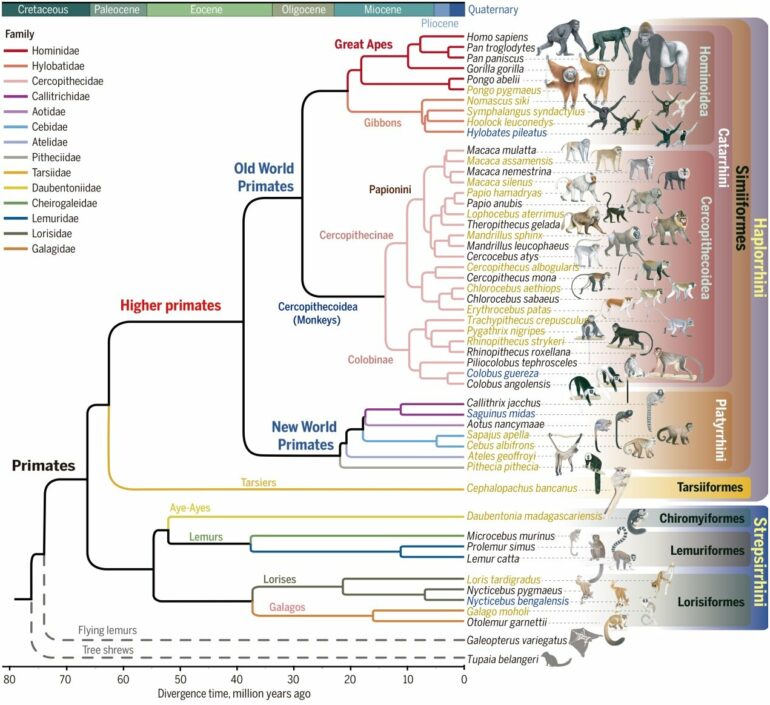Researchers from Zhejiang University, Kunming Institute of Zoology, Northwest University, and Yunnan University, Aarhus University, and BGI-Research have jointly led a series of significant new studies are published in a special issue of the journal Science, and in papers in Nature Ecology & Evolution and Science Advances.
Co-led by Guojie Zhang from Centre for Evolutionary & Organismal Biology at Zhejiang University, Dong-Dong Wu at Kunming Institute of Zoology, Xiao-Guang Qi at Northwest University, Li Yu at Yunnan University, Mikkel Heide Schierup at Aarhus University, and Yang Zhou at BGI-Research, the Primate Genome Consortium reported a series of publications from its first phase program. The program includes high quality reference genomes from 50 primate species, of which 27 were sequenced for the first time. These studies provide new insights on the speciation process, genomic diversity, social evolution, sex chromosomes, and the evolution of the brain and other biological traits.
Large-scale phylogenomic studies reveal the genetic mechanisms underlying the evolutionary history and phenotypic innovations in primates
The comparative analysis of primate genomes within a phylogenetic context is crucial for understanding the evolution of the human genetic architecture and the inter-species genomic differences associated with primate diversification. Previous studies of primate genomes have focused mainly on primate species closely related to humans and were constrained by the lack of broader phylogenetic coverage.
“Although there are more than 500 primate species worldwide, currently, only 23 representative non-human primates species have had their genomes published, leaving 72% of genera remain unsequenced, which creates significant knowledge gaps in understanding their evolutionary history,” Dong-Dong Wu states.

Cold promotes the social evolution of the Asian langurs. © © Xiao-Guang Qi.
To address this gap, the team performed high-quality genome sequencing using long-read sequencing technologies on 27 primate species, including basal lineages that had not been fully sequenced before. Combining this with previously published primate genomes, the project conducted phylogenomic studies of 50 primate species representing 38 genera and 14 families to gain new insights into their genomic and phenotypic evolution.
“Based on full genome data, we have generated a highly resolved phylogeny and estimated the emergence of crown primates between 64.95 and 68.29 million years ago overlapping the Cretaceous/Tertiary boundary,” Dong-Dong Wu states.
The study reported detailed genomic rearrangements across primate lineages and identified thousands of candidate genes that have underwent adaptive natural selection at different ancestral branches of the phylogeny. This includes genes that are important for the development of the nervous, skeletal, digestive, and sensory systems, all of which are likely to have contributed to evolutionary innovations and adaptations of primates.
“It is surprising to see that so many genomic changes involving brain-related genes occurred in the common ancestor of the simian group, which includes [the] New World monkey, Old World monkey, and great apes,” states Guojie Zhang, “These genomic innovations evolving deep in time at this ancestral node might have paved the way for the further evolution of human unique traits.”
Pervasive incomplete lineage sorting illuminates speciation and selection in primates
Although it has been well-recognized that chimpanzees and bonobos are the most closely related species to humans, 15% of our genome is closer to another great ape, the gorilla. This is primarily due to the special evolutionary event called incomplete-lineage sorting (ILS), where the ancestral genetic polymorphism randomly sorts into the descendent species. The study investigated the speciation events during the primate evolution and found ILS occurred frequently in all 29 major ancestral nodes across primates with some nodes having over 50% of genome affected by ILS.
“The genetic diversification process does not follow a bifurcation tree-like topology as we normally know for speciation process, it is more like a complicated net,” Guojie Zhang said. “It is important to investigate the evolutionary process of each individual gene, which could also affect the evolution of phenotypes across species.”
Incomplete lineage sorting (ILS) exhibits extensive variation along the genome, primarily driven by recombination. “We observed that ILS is reduced more on the X chromosome than autosomes compared to what would be expected under neutral evolution, suggesting a higher impact of natural selection on the X chromosome during primate evolution,” Mikkel Heide Schierup states.
The study exploits ILS to perform molecular dating of speciation events solely based on genome data, without fossil calibration, and found the new dating results were highly consistent with the dating with the fossil record. “This suggests that molecular dating provides an accurate estimate of speciation time even without the fossil records,” says the first author of this paper, Iker Rivas-González.

Gray snub-nosed monkey (Rhinopithecus brelichi). © Gui-Yun Li.
Hybridization into species events
Hybridization is increasingly recognized as an important evolutionary force for generating species and phenotypic diversity in plants and animals. This is especially common in lineages that can tolerate whole genome duplication and increased levels of ploidy. However, speciation by hybridization has been rarely reported in mammals.
Utilizing full genome data, the team discovered that the gray snub-nosed monkey Rhinopithecus brelichi was a descendent species from the hybridization between the morphologically differentiated species, the golden snub-nosed monkey R. roxellana and the common ancestor of black-white snub-nosed monkey R. bieti and the black snub- nosed monkey R. strykeri.
“To our knowledge, this is the first time that a hybrid speciation event is recorded in primates,” says Li Yu.
This study further identifies key genes in R. brelichi that derived from each parental lineages which may have contributed to the mosaic coat coloration in this species, and likely promoted premating reproductive isolation of the hybrid species from the parental lineages.
Multidisciplinary intersection reveals the genetic mechanisms of social complexity in Asian langurs
Primates have very diverse social systems; however, the biological mechanisms underlying social evolution remain poorly known. The classical socioecological model hypothesized that the diversity of social systems evolved as a response to the environmental changes.

The hybrid origin of gray snub-nosed monkey. © Li Yu.
The study used Asian colobine monkeys as model system, as this group of species underwent a staged social evolution process from a one-male, multi-female unit to complex multi-level social forms. The researchers reconstructed the speciation process of this group using the full genome data and found a strong correlation between the environmental temperature and group size of the species. The primate species living in colder environments tend to live in larger groups. The ancient ice ages drove the social evolution of these primates, promoting the aggregation of spreading northern odd-nosed monkey species into nested multi-level social forms.
During this transition, odd-nosed monkeys exhibited positive selection in many genes related to cold adaptation and the nervous system. “The snub-nosed monkeys seem to have a longer mother-infant bond, which probably increased infant survival in cold environments, The DA/OXT receptors are important neurohormones in mediating social bonding. This signal pathway has been enhanced in odd-nosed monkey and promoted the social affiliation, cohesion and cooperation among adults of this species,” Xiao-guang Qi states.
More information:
Yong Shao et al, Phylogenomic analyses provide insights into primate evolution, Science (2023). DOI: 10.1126/science.abn6919
Iker Rivas-González et al, Pervasive incomplete lineage sorting illuminates speciation and selection in primates, Science (2023). DOI: 10.1126/science.abn4409
Hong Wu et al, Hybrid origin of a primate, the gray snub-nosed monkey, Science (2023). DOI: 10.1126/science.abl4997
Xiao-Guang Qi et al, Adaptations to a cold climate promoted social evolution in Asian colobine primates, Science (2023). DOI: 10.1126/science.abl8621
Hong Gao et al, The landscape of tolerated genetic variation in humans and primates, Science (2023). DOI: 10.1126/science.abn8197
Lukas F. K. Kuderna et al, A global catalog of whole-genome diversity from 233 primate species, Science (2023). DOI: 10.1126/science.abn7829.
Erik F. Sørensen et al, Genome-wide coancestry reveals details of ancient and recent male-driven reticulation in baboons, Science (2023). DOI: 10.1126/science.abn8153
Petko P. Fiziev et al, Rare penetrant mutations confer severe risk of common diseases, Science (2023). DOI: 10.1126/science.abo1131
Bao-Lin Zhang et al, Comparative genomics reveals the hybrid origin of a macaque group, Science Advances (2023). DOI: 10.1126/sciadv.add3580
Xupeng Bi et al, Lineage-specific accelerated sequences underlying primate evolution, Science Advances (2023). DOI: 10.1126/sciadv.adc9507
Y Zhou et al, Eighty million years of rapid evolution of the primate Y chromosomes, Nature Ecology & Evolution (2023). DOI: doi.org/10.1038/s41559-022-01974-x doi.org/10.1038/s41559-022-01974-x
Citation:
The Primate Genome Project unlocks hidden secrets of primate evolution (2023, June 1)
